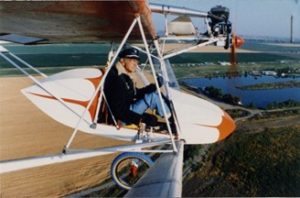About Volmer Jensen
Volmer grew up during the pioneering days of aviation. He was born in Minnesota and moved to Seattle as a teenager. Volmer undertook to get himself airborne. This he did in a homemade hang-glider designed somewhat earlier by Octave Chanute, plans for which appeared in Popular Mechanics magazine. The initial hang glider was followed by a succession of gliders. By 1930, Volmer was an accomplished sailplane pilot whose reputation became well known. He moved to Glendale, California, in 1937 and joined Hawley Bowlus, who was building an experimental twin-engine executive aircraft. In his spare time, Volmer designed and built the VJ-10 high-performance sailplane, which was subsequently purchased by the military for the assault glider training program. Volmer spent the war years in the classroom instructing at Aero Industries Technical Institute. As the war drew to a close, he began formulating plans for an affordable airplane. This was the VJ-21 and it drew heavily upon his experience with sailplanes. One feature pilots found most impressive was its superb forward visibility, unfortunately, the postwar boom in private flying was a bust and the VJ-21 never got to the marketplace. In the late 60’s, with the advent of the new generation of hang gliders, thousands began taking the sky in their “kites.” They were flimsy, for the most part, and lacked control. There was a rash of fatal accidents. Volmer was appalled by what he saw as needless carnage. The result was the VJ-23, which was safe and sturdy. The VJ-23 quickly became popular with aspiring airmen and evolved as the progenitorVolmer Jensen VJ-24W
The VJ-24W is a modified version of the VJ-24E hang glider. Two main wire wheeled bicycle wheels were added as the main landing gear along with the tractor type engine and a full three-axis flight control system. Construction is of aluminum tubing with a Dacron covering material. The fairing behind the pilot significantly reduced the drag on the airplane.
The wingspan is 36’ 6” and the fuselage is built around a keel tube that extends back to the tail group giving it a length of 18’ 6.” The weight of the pilot is restricted to a maximum of 200 pounds. The aircraft empty weight is 165 pounds. The aircraft can climb at 350 feet per minute.


